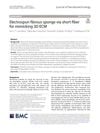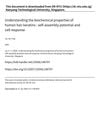Electrospun Fibrous Sponge via Short Fiber for Mimicking 3D Extracellular Matrix
March 2021
in “
Research Square (Research Square)
”
electrospun micro/nanofibrous sponge extracellular matrix ECM cell adhesion cell growth electrospinning thermal crosslinking Human Umbilical Vein Endothelial Cells HUVECs Vascular Endothelial Growth Factor VEGF vascularization chronic diabetes wounds full-thickness skin defects wound healing hair follicle regeneration angiogenesis collagen secretion 3D tissue regeneration

TLDR The new 3D sponge-like material helps cells grow and heals wounds effectively.
The document discusses a study on the fabrication of a 3D electrospun micro/nanofibrous sponge that mimics the natural extracellular matrix (ECM) for cell adhesion and growth. The sponge, created through electrospinning, homogenization, short fiber, and thermal crosslinking, showed high porosity, water absorption, and compression resilience. In vitro studies revealed that the sponge provided an oxygen-rich environment conducive to the growth and 3D proliferation of Human Umbilical Vein Endothelial Cells (HUVECs), stimulating the expression of Vascular Endothelial Growth Factor (VEGF) and promoting vascularization. In vivo studies on rats with chronic diabetes wounds showed that the 3D short fiber sponges adhered well and were more effective than 2D micro/nanofiber membranes in promoting the repair of full-thickness skin defects, including wound healing, hair follicle regeneration, angiogenesis, and collagen secretion. Thus, electrospun short fibrous sponges are potential candidates for mimicking the 3D ECM and promoting 3D tissue regeneration.



